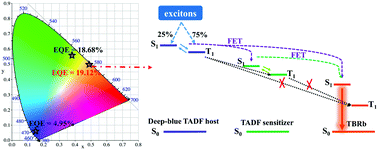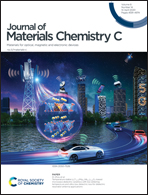A strategy to construct multifunctional TADF materials for deep blue and high efficiency yellow fluorescent devices†
Abstract
Three deep blue thermally activated delayed fluorescence (TADF) molecules are designed by connecting three different sterically hindered electron-donating groups with 2,6-diphenylpyrimidine acceptors. The rigid structures based on carbazole derivatives endow them with excellent thermal stability and high photoluminescence quantum yields (PLQYs) of about 0.72–0.74. A deep blue doped device based on SFI34pPM with a CIEy of 0.09 and a high external quantum efficiency (EQE) of 8.2% is achieved. Also, 3CzPhpPM realizes a maximum EQE of 4.9% with a CIEx,y of (0.15, 0.06). The high PLQY and triplet energy (∼2.84 eV) allow the three deep blue compounds to be used as hosts for yellow TADF emitters, which realized high-performance yellow devices (EQEmax = 18.6%) with alleviated efficiency roll-off. What's more, 3CzPhpPM combined with the TADF sensitizer and the fluorescent material TBRb achieves a high EQE of 19.1%, which is among the best for yellow fluorescent devices. The bipolar transporting ability and the harvesting of triplet excitons together ensure highly efficient yellow devices. Accordingly, these results shed light on the development of designing multifunctional deep blue TADF materials, particularly offering a smart way to construct high efficiency yellow fluorescent devices.



 Please wait while we load your content...
Please wait while we load your content...